The induction brazing services industry stands at the threshold of a decade-long expansion trajectory that promises to reshape metal joining technology, precision manufacturing solutions, and advanced assembly applications. The market's journey from USD 57.5 million in 2025 to USD 97.2 million by 2035 represents substantial growth, demonstrating the accelerating adoption of advanced brazing techniques and specialized joining technology across aerospace manufacturing, automotive production, and electronic assembly sectors.
The first half of the decade (2025-2030) will witness the market climbing from USD 57.5 million to approximately USD 70.9 million, adding USD 13.4 million in value, which constitutes 34% of the total forecast growth period. This phase will be characterized by the rapid adoption of metal brazing service systems, driven by increasing demand for precision joining and the growing need for high-strength assembly requirements worldwide. Advanced temperature control capabilities and flexible process systems will become standard expectations rather than premium options.
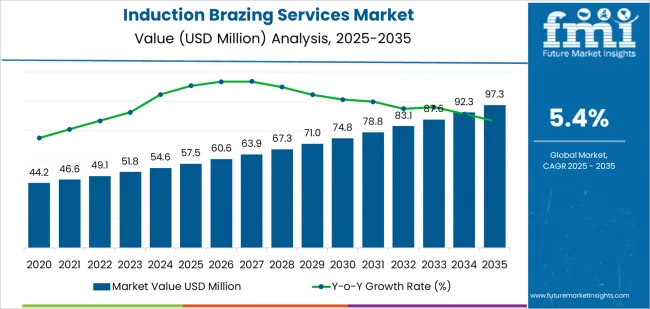
Induction Brazing Services Market Year-over-Year Forecast (2025-2035)
The latter half (2030-2035) will witness sustained growth from USD 70.9 million to USD 97.2 million, adding USD 26.3 million, or 66% of the decade's expansion. This period will be defined by mass market penetration of specialized induction brazing technologies, integration with comprehensive manufacturing platforms, and seamless compatibility with existing production infrastructure. The market trajectory signals fundamental shifts in how manufacturers approach metal joining optimization and assembly quality management, with participants positioned to benefit from sustained demand across multiple material types and end-use application segments.
The induction brazing services market demonstrates distinct growth phases with varying market characteristics and competitive dynamics. Between 2025 and 2030, the market progresses through its technology adoption phase, expanding from USD 57.5 million to USD 70.9 million with steady annual increments averaging 5.4% growth. This period showcases the transition from basic joining processes to advanced metal brazing systems with enhanced precision control capabilities and integrated quality assurance systems becoming mainstream features.
The 2025-2030 phase adds USD 13.4 million to market value, representing 34% of total decade expansion. Market maturation factors include standardization of manufacturing, joining, and assembly protocols, declining service costs for specialized brazing technologies, and increasing industry awareness of induction brazing benefits, reaching optimal joint strength effectiveness in aerospace and automotive applications. Competitive landscape evolution during this period features established service providers like Bodycote and Rogers Metal Service expanding their induction brazing portfolios while specialty companies focus on advanced process development and enhanced quality capabilities.
From 2030 to 2035, market dynamics shift toward advanced material integration and global manufacturing expansion, with growth continuing from USD 70.9 million to USD 97.2 million, adding USD 26.3 million or 66% of total expansion. This phase transition centers on specialized brazing service systems, integration with automated production networks, and deployment across diverse manufacturing and assembly scenarios, becoming standard rather than specialized applications. The competitive environment matures with focus shifting from basic joining capability to comprehensive assembly optimization systems and integration with quality monitoring platforms.
At-a-Glance Metrics
| Metric | Value |
|---|---|
| Market Value (2025) | USD 57.5 million |
| Market Forecast (2035) | USD 97.2 million |
| Growth Rate | 5.4% CAGR |
| Leading Technology | Metal Brazing Material Type |
| Primary Application | Aerospace Application Segment |
The market demonstrates strong fundamentals with metal brazing services capturing a dominant share through advanced joining precision and assembly optimization capabilities. Aerospace applications drive primary demand, supported by increasing high-performance component manufacturing and precision joining technology requirements. Geographic expansion remains concentrated in developed markets with established aerospace and automotive infrastructure, while emerging economies show accelerating adoption rates driven by manufacturing modernization and rising quality standards.
Market expansion rests on three fundamental shifts driving adoption across the aerospace, automotive, and electronic manufacturing sectors. First, precision joining demand creates compelling operational advantages through induction brazing services that provide immediate high-strength bonding and thermal efficiency without compromising assembly quality, enabling manufacturers to meet stringent performance standards while maintaining production efficiency and reducing material stress. Second, manufacturing technology modernization accelerates as component producers worldwide seek advanced brazing processes that complement traditional joining methods, enabling precise temperature control and joint quality that align with industry standards and performance regulations.
Third, lightweight material assembly enhancement drives adoption from aerospace manufacturers and automotive suppliers requiring effective joining solutions that maximize bond strength while maintaining operational precision during assembly and production operations. However, growth faces headwinds from service cost challenges that vary across brazing providers regarding the pricing of specialized equipment and skilled labor, which may limit adoption in cost-sensitive environments. Technical limitations also persist regarding material compatibility and process complexity concerns that may reduce effectiveness in certain assembly requirements and operational scenarios, which affect joining performance and production requirements.
The induction brazing services market represents a specialized yet critical manufacturing opportunity driven by expanding global aerospace production, automotive assembly modernization, and the need for superior metal joining in diverse industrial applications. As manufacturers worldwide seek to achieve optimal joint strength, reduce thermal distortion, and integrate advanced brazing processes with automated platforms, induction brazing services are evolving from basic joining operations to sophisticated assembly solutions ensuring production quality and manufacturing leadership.
The market's growth trajectory from USD 57.5 million in 2025 to USD 97.2 million by 2035 at a 5.4% CAGR reflects fundamental shifts in manufacturing industry joining requirements and assembly process optimization. Geographic expansion opportunities are particularly pronounced in Asia Pacific markets, while the dominance of metal brazing systems and aerospace applications provides clear strategic focus areas.
Strengthening the dominant metal brazing segment through enhanced process capabilities, superior joint quality, and automated control systems. This pathway focuses on optimizing brazing technology, improving joining precision, extending operational effectiveness to optimal strength rates, and developing specialized processes for diverse applications. Market leadership consolidation through advanced thermal engineering and quality integration enables premium positioning while defending competitive advantages against non-metal alternatives. Expected revenue pool: USD 2.1-2.9 million
Rapid aerospace and automotive manufacturing growth across Asia Pacific creates substantial expansion opportunities through local service capabilities and technology transfer partnerships. Growing precision component production and government industrial initiatives drive sustained demand for advanced induction brazing services. Localization strategies reduce logistics costs, enable faster technical support, and position companies advantageously for manufacturing procurement programs while accessing growing domestic markets. Expected revenue pool: USD 1.8-2.5 million
Expansion within the dominant aerospace segment through specialized brazing services addressing critical component standards and high-reliability assembly requirements. This pathway encompasses turbine component joining, heat exchanger assembly, and compatibility with diverse aerospace manufacturing processes. Premium positioning reflects superior joint integrity and comprehensive quality compliance supporting modern aerospace operations. Expected revenue pool: USD 1.5-2.1 million
Strategic expansion into automotive applications requires enhanced production capabilities and specialized brazing processes addressing vehicle component operational requirements. This pathway addresses heat exchanger manufacturing, fuel system assembly, and specialized joining with advanced process engineering for demanding automotive standards. Premium pricing reflects specialized quality requirements and extended reliability standards. Expected revenue pool: USD 1.3-1.8 million
Development of specialized brazing services for electronic manufacturing applications and other segments, addressing specific assembly requirements and niche industrial demands. This pathway encompasses electronic component joining, thermal management assembly, and precision-optimized processes for emerging technology segments. Technology differentiation through specialized capabilities enables diversified revenue streams while reducing dependency on single application platforms. Expected revenue pool: USD 1.1-1.5 million
Expansion of non-metal brazing segment through enhanced material capabilities, ceramic joining properties, and specialized composite applications. This pathway encompasses advanced material assemblies, hybrid component joining, and processes requiring unique material characteristics. Market development through specialized engineering enables differentiated positioning while accessing niche markets requiring alternative brazing solutions. Expected revenue pool: USD 0.9-1.3 million
Development of comprehensive quality systems addressing certification requirements and process validation across aerospace and automotive applications. This pathway encompasses AS9100 compliance, NADCAP certification, and comprehensive traceability documentation. Premium positioning reflects quality leadership and regulatory expertise while enabling access to aerospace procurement programs and quality-driven customer partnerships. Expected revenue pool: USD 0.8-1.1 million
Primary Classification: The market segments by material type into Metal Brazing and Non-metal Brazing categories, representing the evolution from traditional metallic joining to specialized solutions for comprehensive assembly optimization.
Secondary Classification: Application segmentation divides the market into Aerospace, Automotive, Electronic Manufacturing, and Other sectors, reflecting distinct requirements for joint strength, thermal performance, and assembly reliability standards.
Regional Classification: Geographic distribution covers Asia Pacific, Europe, North America, and other regions, with developed markets leading adoption while emerging economies show accelerating growth patterns driven by manufacturing expansion programs.
The segmentation structure reveals technology progression from standard metal joining processes toward specialized brazing systems with enhanced precision and material compatibility capabilities, while application diversity spans from aerospace components to specialized automotive and electronic assemblies requiring precise joining solutions.
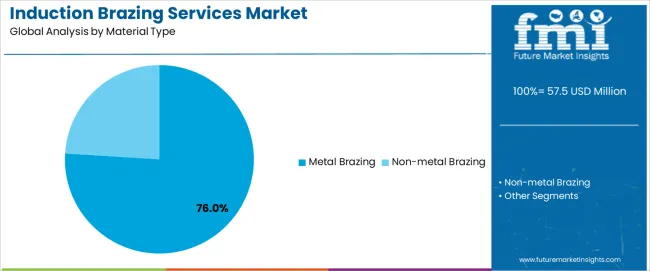
Market Position: Metal brazing services command the leading position in the induction brazing services market with approximately 76.0% market share through advanced process properties, including superior joint strength, optimal thermal efficiency capability, and assembly optimization that enable manufacturers to achieve effective metal joining across diverse industrial environments.
Value Drivers: The segment benefits from manufacturer preference for reliable brazing processes that provide consistent joint quality, reduced thermal distortion, and established material compatibility without requiring experimental process development. Advanced service features enable precision temperature control, automated quality monitoring, and integration with existing manufacturing equipment, where joining performance and process reliability represent critical production requirements.
Competitive Advantages: Metal brazing services differentiate through proven joint integrity, consistent process characteristics, and integration with standard manufacturing operations that enhance assembly effectiveness while maintaining optimal quality suitable for diverse industrial applications.
Key market characteristics:
Non-metal brazing services maintain specialized application positioning in the induction brazing services market due to their unique material properties and advanced composite advantages. These services appeal to manufacturers requiring ceramic joining or composite assembly with specialized capabilities for advanced material applications. Market adoption is driven by specialized component manufacturing, emphasizing unique joining solutions and material compatibility through optimized process engineering systems while maintaining competitive service structures.
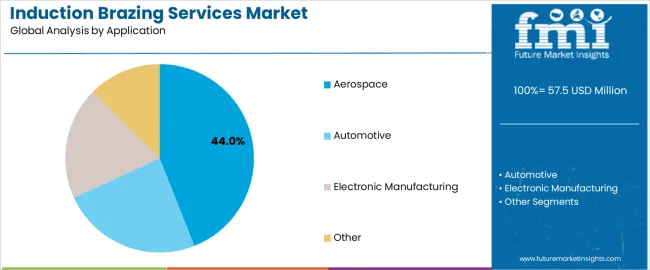
Market Context: Aerospace applications dominate the induction brazing services market with approximately 44.0% market share due to widespread adoption of precision joining technology and increasing focus on critical component assembly, structural integrity, and reliability management applications that minimize failure risks while maintaining aerospace industry standards.
Appeal Factors: Aerospace manufacturers prioritize service reliability, joint quality consistency, and compliance with stringent certification requirements that enable coordinated brazing operations across multiple component types. The segment benefits from substantial aerospace investment and quality programs that emphasize the acquisition of induction brazing services for mission-critical assembly and performance optimization applications.
Growth Drivers: Aircraft component manufacturing programs incorporate induction brazing services as standard processes for aerospace operations, while space exploration initiatives increase demand for high-reliability joining capabilities that comply with certification standards and minimize structural risks.
Market Challenges: Varying aerospace certification standards and material specification differences may limit process standardization across different manufacturing facilities or operational scenarios.
Application dynamics include:
Automotive applications capture significant market share through specialized joining requirements in heat exchanger manufacturing, fuel system production, and vehicle component assembly applications. These facilities demand robust brazing processes capable of maintaining production throughput while providing exceptional joint quality and reliability capabilities.
Growth Accelerators: Aerospace manufacturing expansion drives primary adoption as induction brazing services provide superior joining capabilities that enable component producers to meet stringent quality standards without excessive process complexity, supporting aerospace operations and critical assembly missions that require precise metal joining applications. Lightweight material assembly demand accelerates market expansion as manufacturers seek effective brazing processes that optimize joint strength while maintaining thermal efficiency during production and assembly scenarios. Manufacturing technology spending increases worldwide, creating sustained demand for advanced joining services that complement modern assembly processes and provide quality optimization in competitive markets.
Growth Inhibitors: Service cost challenges vary across brazing providers regarding the pricing of specialized equipment and skilled technicians, which may limit operational flexibility and market penetration in regions with cost constraints or price-sensitive manufacturing operations. Technical complexity limitations persist regarding material compatibility and process parameter concerns that may reduce effectiveness in certain assembly scenarios, material combinations, or production conditions, affecting joining quality and manufacturing requirements. Market fragmentation across multiple industry certification standards and quality approaches creates qualification concerns between different service providers and existing manufacturing protocols.
Market Evolution Patterns: Adoption accelerates in aerospace component and automotive heat exchanger sectors where joint reliability justifies service costs, with geographic concentration in developed markets transitioning toward mainstream adoption in emerging economies driven by manufacturing expansion and quality awareness. Process development focuses on enhanced temperature control, improved automation capabilities, and compatibility with advanced materials that optimize joint quality and assembly effectiveness. The market could face disruption if alternative joining technologies or solid-state bonding innovations significantly limit the deployment of induction brazing in manufacturing applications, though induction brazing's unique combination of precision control, joint strength, and thermal efficiency continues to make it preferred in high-performance assembly applications.
The induction brazing services market demonstrates varied regional dynamics with Growth Leaders including China (7.3% CAGR) and India (6.8% CAGR) driving expansion through manufacturing capacity additions and aerospace development programs. Steady Performers encompass Germany (6.2% CAGR), Brazil (5.7% CAGR), and United States (5.1% CAGR), benefiting from established aerospace industries and advanced manufacturing technology adoption. Mature Markets feature United Kingdom (4.6% CAGR) and Japan (4.1% CAGR), where specialized precision assembly applications and quality system integration support consistent growth patterns.

| Country | CAGR (2025-2035) |
|---|---|
| China | 7.3% |
| India | 6.8% |
| Germany | 6.2% |
| Brazil | 5.7% |
| United States | 5.1% |
| United Kingdom | 4.6% |
| Japan | 4.1% |
Regional synthesis reveals Asia Pacific markets leading adoption through aerospace manufacturing expansion and automotive production development, while European countries maintain strong expansion supported by precision engineering advancement and quality standardization requirements. North American markets show solid growth driven by aerospace component applications and manufacturing modernization trends.
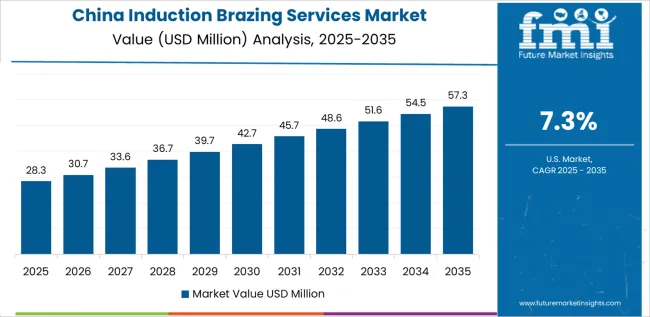
The Chinese market emphasizes advanced brazing features, including precision joint control and integration with comprehensive manufacturing platforms that manage assembly quality, process optimization, and production performance applications through unified industrial systems. The country demonstrates strong growth at 7.3% CAGR, driven by aerospace manufacturing expansion, automotive production initiatives, and emerging technology development that support induction brazing service integration. Chinese manufacturers prioritize operational effectiveness with brazing services delivering consistent joint quality through advanced process capabilities and production adaptation features.
Technology deployment channels include major aerospace manufacturers, specialized brazing service providers, and industrial procurement programs that support professional applications for complex component assembly and heat exchanger fabrication applications. Manufacturing system integration capabilities with established production platforms expand market appeal across diverse operational requirements seeking joint quality and efficiency benefits. The expanding aerospace sector and accelerating automotive production create sustained demand, while innovative applications in electronic manufacturing and precision assembly open new growth avenues.
Performance Metrics:
Germany's advanced manufacturing market demonstrates sophisticated brazing service deployment with documented operational effectiveness in aerospace component assembly and automotive production facilities through integration with existing quality systems and manufacturing infrastructure. The country leverages engineering expertise in joining technology and industrial systems integration to maintain strong growth at 6.2% CAGR. Industrial centers, including Bavaria, Baden-Württemberg, and Lower Saxony, showcase advanced installations where induction brazing services integrate with comprehensive manufacturing platforms and quality management systems to optimize production operations and joining effectiveness.
German manufacturers prioritize system quality and aerospace certification compliance in service development, creating demand for premium brazing services with advanced features, including NADCAP certification and automated quality documentation. The market benefits from established aerospace infrastructure and a willingness to invest in advanced joining technologies that provide long-term quality benefits and compliance with international aerospace and quality standards.
Market Intelligence Brief:
The USA induction brazing services market demonstrates sophisticated deployment across aerospace applications with documented effectiveness in critical component manufacturing and assembly facilities through integration with comprehensive quality management systems and certification infrastructure. The country leverages advanced aerospace capabilities in joining technology and quality optimization technologies to maintain solid growth at 5.1% CAGR. Aerospace centers, including California, Texas, and Connecticut, showcase advanced installations where brazing services integrate with comprehensive manufacturing platforms and quality networks to optimize production operations and assembly effectiveness.
American aerospace manufacturers prioritize quality assurance and certification compliance in service development, creating demand for advanced brazing services with sophisticated features, including AS9100 compliance and full traceability systems. The market benefits from established aerospace infrastructure and willingness to invest in certified joining technologies that provide long-term reliability benefits and compliance with FAA and industry standards.
Market Intelligence Brief:
The UK induction brazing services market demonstrates advanced quality deployment with documented operational effectiveness in aerospace applications and precision manufacturing facilities through integration with existing certification systems and quality infrastructure. The country leverages regulatory expertise in aerospace standards and service systems integration to maintain steady growth at 4.6% CAGR. Manufacturing centers, including West Midlands, North West England, and Scotland, showcase advanced installations where brazing services integrate with comprehensive quality platforms and certification management systems to optimize compliance and assembly effectiveness.
British manufacturers prioritize system certification and quality compliance in service development, creating demand for certified brazing services with advanced features, including full traceability integration and quality monitoring systems. The market benefits from established aerospace infrastructure and commitment to invest in certified joining technologies that provide long-term quality benefits and compliance with UK and EU aerospace standards.
Strategic Market Indicators:
India's induction brazing services market demonstrates rapid expansion deployment with documented operational effectiveness in manufacturing applications and industrial facilities through integration with emerging aerospace systems and production infrastructure. The country leverages growing industrial capabilities in precision manufacturing and service systems integration to achieve high growth at 6.8% CAGR. Manufacturing centers, including Maharashtra, Karnataka, and Tamil Nadu, showcase expanding installations where brazing services integrate with comprehensive manufacturing platforms and quality networks to optimize market penetration and assembly effectiveness.
Indian manufacturers prioritize cost-effectiveness and service functionality in process development, creating demand for accessible brazing services with essential features, including adequate joint quality and standard process capabilities. The market benefits from expanding aerospace infrastructure and willingness to invest in international-standard joining technologies that provide quality optimization and competitive positioning.
Market Intelligence Brief:
Japan's induction brazing services market demonstrates precision deployment with documented operational effectiveness in advanced aerospace applications and specialty manufacturing facilities through integration with sophisticated quality systems and certification infrastructure. The country leverages technological excellence in precision engineering and service systems integration to maintain steady growth at 4.1% CAGR. Manufacturing centers, including Tokyo, Aichi, and Osaka, showcase premium installations where brazing services integrate with comprehensive quality platforms and process optimization systems to achieve manufacturing excellence and joining effectiveness.
Japanese manufacturers prioritize system precision and quality excellence in service development, creating demand for high-quality brazing services with advanced features, including micro-precision control and superior certification compliance. The market benefits from established aerospace infrastructure and commitment to invest in highest-quality joining technologies that provide superior production positioning and compliance with stringent Japanese aerospace standards.
Strategic Market Indicators:

The induction brazing services market in Europe is projected to grow substantially over the forecast period, with Germany expected to maintain its leadership position with a significant market share supported by its advanced aerospace infrastructure and major manufacturing centers in Bavaria and Baden-Württemberg. France follows with strong market presence, driven by comprehensive aerospace programs and precision manufacturing initiatives. The United Kingdom holds substantial market share through specialized aerospace activities, quality certification applications, and precision component assembly. Italy commands notable market presence through growing aerospace manufacturing and joining technology projects. Spain accounts for expanding market share aided by aerospace capacity expansion and manufacturing technology adoption. The Netherlands maintains steady share driven by specialty aerospace applications and precision assembly demand. The Rest of Europe region is anticipated to show steady adoption, reflecting consistent growth in Nordic countries, aerospace expansion in Central European markets, and manufacturing technology upgrades across Eastern European production facilities.

In Japan, the induction brazing services market prioritizes metal brazing processes, which capture the dominant share of aerospace component and precision manufacturing installations due to their advanced features, including superior joint strength optimization and seamless integration with existing aerospace manufacturing infrastructure. Japanese manufacturers emphasize reliability, process precision, and quality excellence, creating demand for metal brazing services that provide comprehensive joining capabilities and superior assembly performance based on aerospace requirements and quality standards. Non-metal brazing maintains secondary positions primarily in specialized composite applications and advanced material installations where ceramic joining functionality meets operational requirements without compromising assembly efficiency.
Market Characteristics:
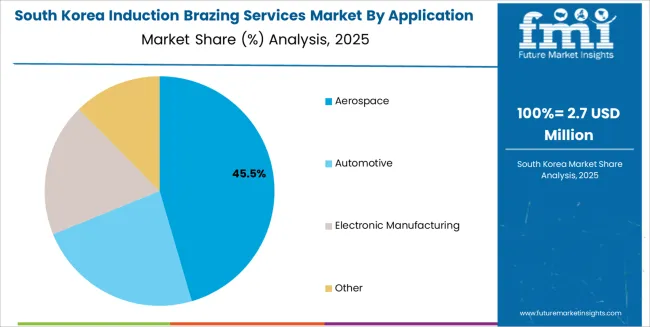
In South Korea, the market structure favors international service providers, including Bodycote, Rogers Metal Service, and specialized brazing companies, which maintain dominant positions through comprehensive service portfolios and established aerospace industry networks supporting both component manufacturers and assembly installations. These providers offer integrated solutions combining advanced induction brazing services with professional technical support and ongoing quality assurance that appeal to Korean manufacturers seeking reliable joining processes. Local manufacturing service companies and precision assembly specialists capture moderate market share by providing localized technical capabilities and competitive pricing for standard aerospace applications, while domestic providers focus on specialized services and cost-effective solutions tailored to Korean manufacturing characteristics.
Channel Insights:
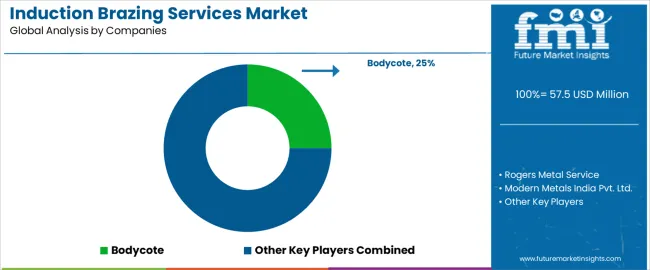
The induction brazing services market operates with moderate concentration, featuring approximately 12-15 meaningful participants, where leading companies control roughly 55-60% of the global market share through established aerospace relationships and comprehensive brazing service portfolios. Competition emphasizes advanced process capabilities, quality certification, and customer integration rather than price-based rivalry. The leading companies maintain competitive positions through extensive joining technology expertise and global aerospace industry presence.
Market Leaders encompass Bodycote, Rogers Metal Service, Modern Metals India, and Enrx, which maintain competitive advantages through extensive brazing technology expertise, global aerospace networks, and comprehensive quality certification capabilities that create customer loyalty and support service-based pricing. These companies leverage decades of joining technology experience and ongoing process investments to develop advanced induction brazing services with precision control and quality assurance features. Technology Innovators include Braze Solutions LLC, Tube Bending Inc, C&H Machine, Zion Industries, and regional specialists, which compete through specialized brazing process focus and innovative joining capabilities that appeal to aerospace manufacturers seeking advanced assembly solutions and quality optimization. These companies differentiate through rapid service qualification cycles and specialized aerospace application focus.
Regional Specialists feature service providers focusing on specific geographic markets and specialized applications, including NADCAP-certified systems and automated assembly solutions. Market dynamics favor participants that combine reliable process performance with advanced quality capabilities, including precision temperature control and automatic inspection optimization features. Competitive pressure intensifies as traditional heat treating companies expand into induction brazing services, while specialized joining technology providers challenge established players through innovative process solutions and comprehensive platforms targeting aerospace and automotive segments.
| Item | Value |
|---|---|
| Quantitative Units | USD 57.5 million |
| Material Type | Metal Brazing, Non-metal Brazing |
| Application | Aerospace, Automotive, Electronic Manufacturing, Other |
| Regions Covered | Asia Pacific, Europe, North America, Latin America, Middle East & Africa |
| Countries Covered | China, India, Germany, Brazil, United States, United Kingdom, Japan, and 20+ additional countries |
| Key Companies Profiled | Bodycote, Rogers Metal Service, Modern Metals India Pvt. Ltd., Enrx, Braze Solutions LLC, Tube Bending Inc, C&H Machine, Inc., Zion Industries, Hoverdale, Legacy Brazing, Byron Products, Aalberts |
| Additional Attributes | Dollar sales by material type and application categories, regional adoption trends across Asia Pacific, Europe, and North America, competitive landscape with specialized service providers and aerospace suppliers, manufacturer preferences for joint quality and process reliability, integration with aerospace manufacturing platforms and quality monitoring systems, innovations in temperature control formulations and process excellence, and development of automated inspection solutions with enhanced performance and quality optimization capabilities. |
The global induction brazing services market is estimated to be valued at USD 57.5 million in 2025.
The market size for the induction brazing services market is projected to reach USD 97.3 million by 2035.
The induction brazing services market is expected to grow at a 5.4% CAGR between 2025 and 2035.
The key product types in induction brazing services market are metal brazing and non-metal brazing.
In terms of application, aerospace segment to command 44.0% share in the induction brazing services market in 2025.






Full Research Suite comprises of:
Market outlook & trends analysis
Interviews & case studies
Strategic recommendations
Vendor profiles & capabilities analysis
5-year forecasts
8 regions and 60+ country-level data splits
Market segment data splits
12 months of continuous data updates
DELIVERED AS:
PDF EXCEL ONLINE
Induction Cooktop Market Forecast and Outlook 2025 to 2035
Induction Furnace Market Size and Share Forecast Outlook 2025 to 2035
Induction Hob Market Size and Share Forecast Outlook 2025 to 2035
Induction Sealing Machines Market Size and Share Forecast Outlook 2025 to 2035
Induction Motors Market - Growth & Demand 2025 to 2035
Market Share Breakdown of Induction Sealing Machines Manufacturers
Heat Induction Cap Liner Market Size and Share Forecast Outlook 2025 to 2035
Analysis and Growth Projections for Powder Induction and Dispersion Systems Business
Vertical Induction Hardening System Market Size and Share Forecast Outlook 2025 to 2035
Portable Induction Hobs Market Trends & Forecast 2025 to 2035
Commercial Induction Cooktops Market Growth - Trends & Forecast 2025 to 2035
High Magnetic Induction Grain-Oriented Silicon Steel Market Size and Share Forecast Outlook 2025 to 2035
Brazing Strips Market Growth - Trends & Forecast 2025 to 2035
Brazing Torch Market Growth - Trends & Forecast 2025 to 2035
Brazing Consumables Market
M2M Services Market Size and Share Forecast Outlook 2025 to 2035
B2B Services Review Platforms Market Size and Share Forecast Outlook 2025 to 2035
Bot Services Market Size and Share Forecast Outlook 2025 to 2035
Spa Services Market Size and Share Forecast Outlook 2025 to 2035
Microservices Orchestration Market Growth - Trends & Forecast 2025 to 2035

Thank you!
You will receive an email from our Business Development Manager. Please be sure to check your SPAM/JUNK folder too.
Chat With
MaRIA